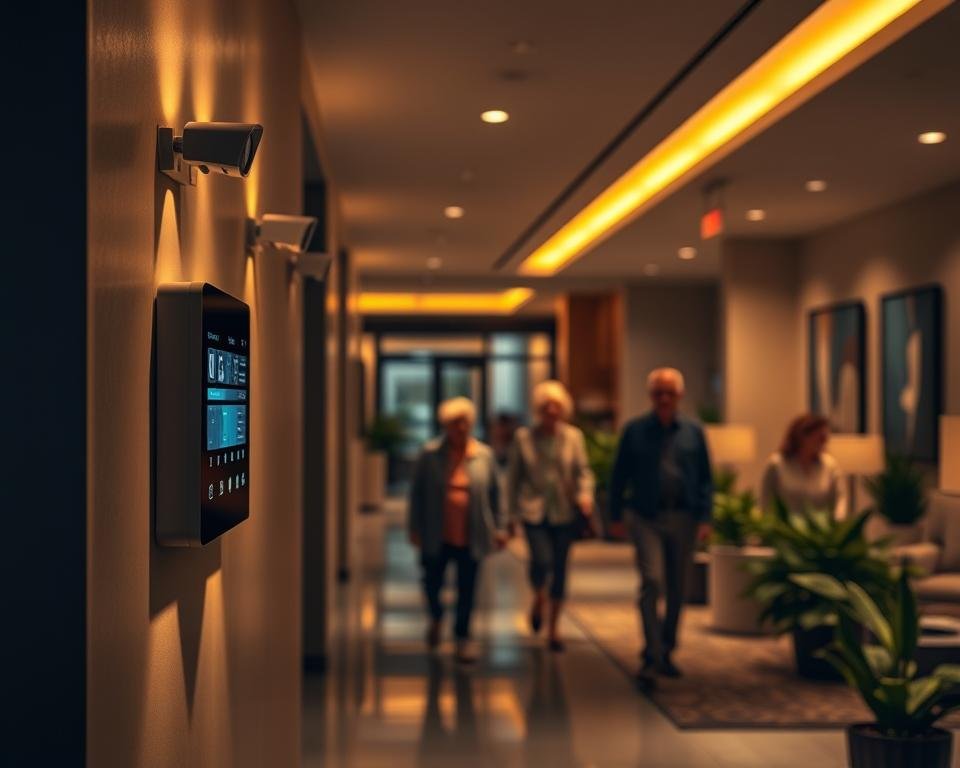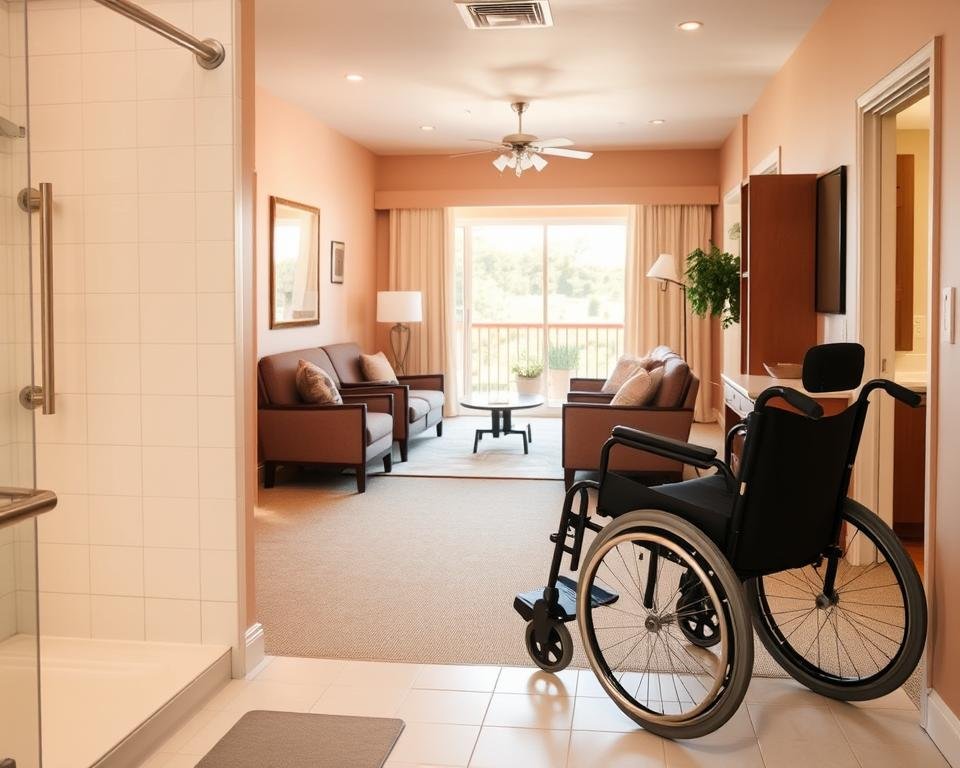Did you know 82% of older adults say feeling secure is their top concern when choosing a new home? Modern retirement options go far beyond basic amenities, offering tailored protections that blend freedom with reassurance. Let’s explore how today’s senior-focused environments prioritize well-being while fostering vibrant lifestyles.
Unlike standard apartments, these spaces integrate age-friendly designs at every turn. Wider doorways accommodate mobility aids, while slip-resistant flooring reduces fall risks. Grab bars in bathrooms and emergency pull cords ensure help arrives fast if needed.
Communities like The Lafayette showcase advanced safety systems, including monitored entry points and round-the-clock staff. Motion-activated lighting and video surveillance add layers of protection without sacrificing comfort. Regular inspections address potential hazards before they become issues.
You’ll also find social activities and wellness programs that build connections. This combination of physical safeguards and engaged living creates a true sense of belonging. Families appreciate knowing loved ones thrive in spaces designed for both joy and security.
Key Takeaways
- Modern senior-focused homes prioritize accessibility through features like non-slip floors and emergency call systems.
- 24/7 on-site staff and monitored entry points provide immediate assistance when required.
- Proactive maintenance checks prevent accidents before they occur.
- Social engagement opportunities complement physical safety measures.
- Custom designs balance independence with personalized support networks.
Overview of Safety Considerations in Senior Living Communities
Choosing the right home as you age involves more than comfort—it’s about finding a space that evolves with your needs. Modern retirement environments blend thoughtful design with proactive support, offering advantages most houses lack. From emergency call buttons in bathrooms to staff trained in fall prevention, these spaces prioritize well-being without sacrificing autonomy.
Understanding the Unique Needs of Seniors
Purpose-built layouts reduce everyday risks. Motion sensors detect unusual activity, while grab bars in showers provide stability. “We design for how people actually live, not just checklists,” notes Joe Munizza, a community director. Regular wellness checks and medication reminders add layers of protection traditional homes can’t match.
Comparing Care Options
Unlike assisted living facilities, these environments focus on prevention over intervention. Secure entry systems and 24/7 emergency response teams offer peace of mind. For example, communities with advanced security features use keypad access and video monitoring to balance privacy with vigilance.
Social connections also play a role. Shared activities and neighbor networks create natural check-ins. This blend of smart technology and human care builds an environment where you thrive—not just reside.
Enhanced Security and Emergency Response Systems
What gives families confidence when choosing a retirement residence? Modern spaces combine advanced technology with human-centered design to create environments where you feel protected yet unrestricted. Let’s explore how these systems work together seamlessly.

Smart Access Control
Gated entries with biometric scanners or personalized keycards ensure only approved individuals enter. At The Lafayette, visitors must pass through two verification points before accessing resident areas. Video doorbells with facial recognition add another layer of oversight without feeling intrusive.
Always-On Support Networks
Emergency pullcords connect directly to staff stations, triggering location-specific alerts. “Our team reaches any apartment within 90 seconds,” shares a Lafayette care coordinator. Round-the-clock concierge services handle everything from medication reminders to coordinating urgent medical transport.
Fire Prevention Innovations
Multi-sensor detectors differentiate between cooking smoke and dangerous fumes. Automated sprinklers activate only in affected zones, minimizing water damage. Monthly system tests and certified technician reviews keep these features operational when seconds count.
These measures work behind the scenes, allowing you to focus on enjoying daily life. Regular drills ensure both residents and staff know evacuation routes, while well-lit exit paths accommodate mobility devices. It’s protection that adapts as needs change.
Accessibility Features and Design for Independent Living
Imagine moving through your home with ease, where every detail supports your freedom to live fully. Modern retirement spaces now prioritize accessibility from the ground up, blending practical solutions with thoughtful layouts.

Built-In Accessibility: Walkways, Doorways, and Bathrooms
At The Lafayette, doorways stretch 36 inches wide for smooth wheelchair passage. Step-free entries eliminate tripping hazards, while motion-activated lighting guides nighttime movement. Bathrooms showcase:
- Walk-in showers with fold-down seats
- Adjustable handheld showerheads
- Anti-slip tile patterns that look like modern art
Lever-style handles replace knobs for arthritic hands, and kitchen counters adjust height with a button press. “Our designs let you focus on living, not limitations,” shares a Lafayette architect.
Innovative Design for Mobility and Independence
Curved hallways with handrails double as art displays, proving function can be beautiful. Outdoor paths feature gentle slopes and resting benches every 50 feet. Monthly walkthroughs identify areas needing updates, like adding voice-activated thermostats.
These features empower you to maintain independence while knowing support exists if required. Next, discover how proactive upkeep keeps these systems running smoothly year after year.
Prompt Maintenance and Proactive Safety Measures
A well-maintained home isn’t just comfortable—it’s your first line of defense against unexpected issues. Modern retirement environments thrive through meticulous care routines that keep every system humming smoothly.

Dedicated teams conduct weekly walkthroughs to spot worn carpets, flickering lights, or loose handrails. “We treat every repair request as urgent,” explains Maria Torres, a maintenance director at The Lafayette. This approach ensures appliances, door locks, and emergency alarms function flawlessly when needed most.
Regular Safety Inspections and Repairs
Monthly checks verify smoke detectors and carbon monoxide sensors meet current standards. Staff test emergency call buttons in bathrooms and bedrooms, replacing batteries proactively. When a resident reported a slow-draining kitchen sink last week, technicians resolved it within two hours—preventing potential water damage.
Preventative Upkeep of Essential Safety Systems
Quarterly HVAC inspections maintain air quality, while annual fire suppression system reviews ensure quick response times. Communities like those featured in recent guides use predictive maintenance software to schedule updates before issues arise.
These efforts create environments where you can relax, knowing professionals handle the details. Regular upkeep not only prevents accidents but also preserves the value of shared spaces, making every day feel worry-free.
Safety in Independent Living Communities for Seniors: Best Practices
Creating a secure environment requires both smart systems and caring connections. The most effective retirement spaces blend technology with human touchpoints, ensuring you stay protected while maintaining autonomy.
Teamwork Makes Safety Work
Top-rated locations combine staff training with resident involvement. Monthly safety workshops teach emergency call system operation and fire drill protocols. “Our team completes quarterly de-escalation training,” notes a coordinator at The Lafayette. Regular wellness checks and medication reviews add layers of oversight.
Three elements create robust protection:
- Bi-weekly walkthroughs to update lighting and clear walkways
- Anonymous suggestion boxes for protocol improvements
- Social mixers that build neighborly watch networks
Your Role in Staying Secure
Simple habits enhance daily confidence. Test emergency pull cords during monthly apartment checks. Join community safety committees to voice concerns. Keep walkers charged and pathways clutter-free.
Many find peace of mind through:
- Storing medical alerts near phones
- Sharing activity calendars with staff
- Attending balance improvement classes
These strategies work best when paired with 24/7 response teams and updated access controls. By combining personal awareness with professional support, you create living spaces that adapt as needs evolve.
Conclusion
Finding a home that supports your lifestyle while prioritizing well-being becomes essential as needs evolve. Modern senior-focused environments combine advanced security systems with thoughtful design, offering layers of protection that work quietly in the background. From emergency response teams to accessibility-focused layouts, every detail aims to preserve your autonomy.
These spaces thrive through proactive maintenance and community-driven care. Regular system checks ensure devices function flawlessly, while staff training and neighbor networks create natural safety nets. Social events and wellness programs foster connections that enrich daily life beyond physical safeguards.
When exploring housing options, consider how top communities blend technology with human-centered care. Tours let you experience features like biometric entry systems or adjustable kitchen counters firsthand. Choosing such environments means investing in quality surroundings where you can thrive confidently.
Peace of mind comes from knowing professionals handle risks so you can focus on living fully. With the right balance of innovation and support, your next chapter becomes an opportunity to embrace freedom without compromise.
